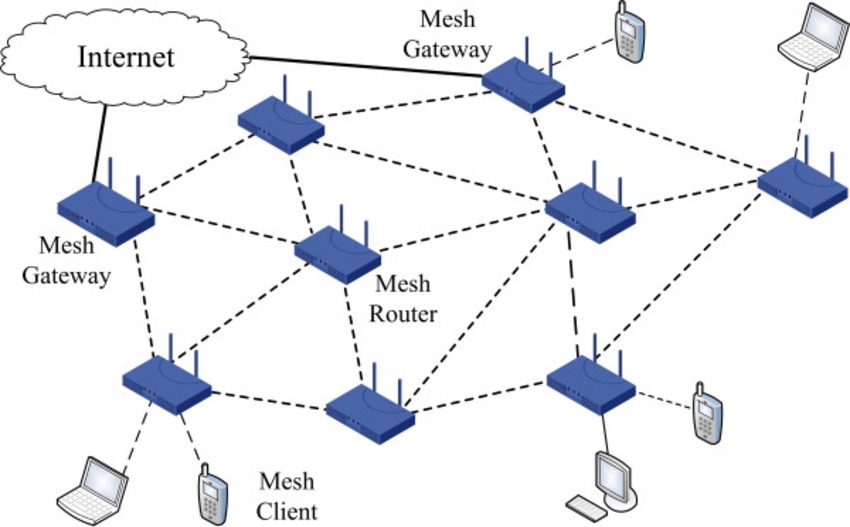
Why Mesh Networks Might Replace Wi-Fi.
Mesh networks are transforming wireless connectivity by providing seamless coverage, self-healing connections, and intelligent data routing that traditional Wi-Fi struggles to achieve. As homes, offices, and cities become increasingly connected with smart devices, mesh networking offers a scalable, reliable, and future-ready solution, making it poised to replace conventional Wi-Fi systems and redefine how we experience the internet.
✨ Raghav Jain

Introduction: The Wi-Fi Revolution and Its Limitations
Wi-Fi has transformed how we connect to the internet. From homes to workplaces, it powers everything—streaming, remote work, IoT devices, and communication. However, as our need for high-speed, reliable, and consistent connectivity grows, Wi-Fi’s weaknesses are becoming more apparent. Dead zones, bandwidth bottlenecks, and single-router limitations plague even modern Wi-Fi systems.
Enter mesh networking, a technology designed to solve these persistent connectivity issues. While traditional Wi-Fi depends on a single central router, mesh networks use multiple nodes that work together to create a unified, self-sustaining web of connectivity. Each node communicates with others, ensuring that the signal stays strong and uninterrupted throughout the coverage area.
This article explores how mesh networks work, their advantages over Wi-Fi, and why they are poised to replace traditional Wi-Fi systems in homes, businesses, and smart cities of the future.
Understanding Mesh Networks: How They Work
A mesh network is composed of multiple nodes (or access points) that act as peers rather than depending on a central router. Each node is capable of sending and receiving data to and from nearby nodes, effectively creating a web—or “mesh”—of connectivity.
Unlike Wi-Fi, where devices must connect directly to one router, mesh systems allow data to take the most efficient route through multiple nodes to reach its destination. This routing flexibility provides several key benefits:
- Redundancy: If one node fails or is out of range, data automatically reroutes through another node.
- Extended Coverage: Each node extends the overall network range, eliminating dead spots.
- Self-Healing: The system adapts in real-time to maintain connectivity even when interference or congestion occurs.
- Seamless Roaming: Users can move around large areas without disconnecting or switching networks.
This dynamic structure makes mesh networks particularly useful in environments where consistent coverage is crucial—such as large homes, office buildings, and outdoor campuses.
Traditional Wi-Fi vs. Mesh Networking
Feature Traditional Wi-Fi Mesh Network Coverage Limited to router range Expands with each node Performance Degrades with distance Consistent across area Scalability Difficult to expand Easily scalable by adding nodes Reliability Single point of failure Self-healing multi-node system Setup Complexity Requires extenders or repeaters Simple app-based setup Mobility Device reconnects when moving Seamless roaming between nodes Traditional Wi-Fi systems rely heavily on a single router or, in larger setups, on range extenders. These extenders often halve bandwidth because they must both receive and retransmit signals. In contrast, mesh systems allow data to “hop” intelligently between nodes, maintaining full bandwidth and minimizing latency.
Advantages of Mesh Networks
1. Complete Coverage
Mesh systems eliminate Wi-Fi dead zones by creating overlapping coverage zones. Each node ensures that even remote corners of a house, office, or warehouse receive a stable signal.
2. Self-Healing and Reliability
When one node goes offline, the others reroute data automatically, ensuring continuous connectivity. This feature makes mesh networks highly reliable, especially in mission-critical environments like hospitals, factories, and corporate networks.
3. Scalability
Adding more devices to a Wi-Fi network often causes congestion. In contrast, mesh networks thrive on expansion. Adding more nodes actually strengthens the network by increasing connection pathways.
4. Seamless User Experience
Mesh networks enable seamless roaming. You can move from one room to another, or even between floors, without your connection dropping or switching networks manually.
5. Intelligent Traffic Management
Many mesh systems use artificial intelligence (AI) and advanced algorithms to optimize data flow, reduce latency, and prioritize critical devices like streaming boxes or work laptops.
6. Simplified Setup and Control
Modern mesh systems (like Google Nest Wi-Fi, Eero, or TP-Link Deco) offer app-based configuration and monitoring. Users can manage connected devices, set parental controls, or troubleshoot remotely with ease.
7. Ideal for Smart Homes
As homes fill with IoT devices—thermostats, cameras, locks, speakers—traditional routers struggle to handle so many connections. Mesh networks distribute the load across multiple nodes, ensuring every device gets adequate bandwidth and low latency.
Mesh Networks in Action: Real-World Applications
1. Smart Homes
Mesh systems are becoming the backbone of smart homes, supporting dozens of IoT devices simultaneously. They ensure reliable connections for everything from video doorbells to voice assistants.
2. Offices and Enterprises
In corporate settings, mesh networks can cover entire floors or multi-building campuses without expensive cabling or complex network architecture. They also support secure guest access and easy scalability.
3. Public Spaces
Cities and municipalities are experimenting with municipal mesh networks to provide public Wi-Fi. Unlike traditional public hotspots, these networks offer consistent coverage across large outdoor areas.
4. Rural and Remote Connectivity
Mesh networking helps extend internet access to remote or underserved areas without the need for complex infrastructure. This can bridge the digital divide in developing regions.
5. Emergency Response and Military Use
In disaster zones or combat fields where infrastructure is destroyed or absent, mesh networks can be deployed rapidly. Their self-healing nature ensures resilient communication even under harsh conditions.
Challenges and Limitations of Mesh Networks
Despite their advantages, mesh networks are not perfect. Some key limitations include:
- Cost: High-quality mesh systems can be expensive compared to standard routers.
- Backhaul Performance: If the backhaul (data between nodes) relies on wireless connections, congestion or interference can reduce speed. Wired backhaul options help but increase complexity.
- Compatibility: Some mesh systems work best when all nodes are from the same manufacturer.
- Security Risks: As with all wireless networks, mesh systems are vulnerable if not updated or secured properly.
- Power Dependency: Each node requires power, which may be impractical in certain outdoor or mobile scenarios.
However, ongoing advancements in mesh technology and 6GHz spectrum (Wi-Fi 6E and Wi-Fi 7) are addressing many of these issues, bringing mesh networking closer to mainstream adoption.
Future Outlook: The Path Beyond Wi-Fi
The boundary between Wi-Fi and mesh networking is beginning to blur. Wi-Fi 7 technology, for example, incorporates features like multi-link operation (MLO) that mimic mesh behavior. Moreover, 5G and satellite internet technologies are likely to integrate with mesh systems, creating hybrid connectivity networks that automatically route data through the best available channel.
In the coming decade, we may see:
- Smart cities powered by interconnected mesh nodes providing ubiquitous connectivity.
- Homes using hybrid mesh systems that combine 5G and Wi-Fi seamlessly.
- Edge computing integration, where mesh nodes perform localized data processing for faster IoT performance.
Ultimately, the shift from traditional Wi-Fi to mesh networking represents more than just better connectivity—it signifies a move toward intelligent, distributed, and resilient communication systems that evolve with user needs.
For more than two decades, Wi-Fi has been the foundation of our wireless connectivity, powering homes, offices, and public spaces worldwide. It has made the internet accessible, portable, and indispensable. Yet as technology evolves and our digital needs become more complex, traditional Wi-Fi systems are showing cracks in their armor—limited coverage, dead zones, and inconsistent performance in multi-device environments have become common complaints. Enter mesh networking, a new form of wireless connectivity that promises to overcome these limitations and redefine how we experience the internet. A mesh network is a system made up of multiple nodes or access points that work together to create a unified and self-healing web of connectivity. Unlike traditional Wi-Fi, which depends on a single router as the central hub, mesh networks distribute data across several nodes that communicate with one another directly. This setup allows information to take the fastest, most efficient route to its destination, ensuring strong, consistent coverage even in large or complex spaces. Imagine your home as a series of rooms connected not by one light bulb in the hallway but by multiple interconnected lights that share power and brightness—no matter where you go, the light follows you seamlessly. That’s the essence of mesh networking. The advantage of this approach becomes clear when compared with traditional Wi-Fi systems. A single router’s signal weakens as you move farther away, and physical barriers like walls, doors, and floors further degrade performance. Range extenders or repeaters can help, but they often halve the available bandwidth since they must receive and retransmit data simultaneously. Mesh networks solve these issues by allowing each node to act as both a transmitter and receiver, intelligently routing data through multiple pathways. If one node fails or encounters interference, another automatically takes over, creating a self-healing system that maintains connectivity without user intervention. This architecture not only eliminates dead zones but also enhances reliability and scalability. Want to expand your network? Simply add another node—no complex setup or configuration required. Mesh systems like Google Nest Wi-Fi, Eero, and TP-Link Deco are designed for plug-and-play simplicity, often managed through user-friendly mobile apps that provide complete control over the network. Users can monitor traffic, prioritize devices, set parental controls, or create guest networks—all with a few taps. Beyond convenience, mesh networks offer significant performance benefits. They deliver consistent bandwidth across wide areas, support seamless roaming (allowing devices to switch nodes without disconnecting), and intelligently manage data traffic using AI-based algorithms. For instance, when multiple devices stream, game, or download simultaneously, the network dynamically allocates resources to ensure optimal speed and minimal lag for all. This makes mesh networks ideal not just for large homes but also for offices, schools, and public environments. Moreover, as the number of connected devices grows exponentially—thanks to the Internet of Things (IoT)—traditional routers are struggling to handle the load. Smart speakers, cameras, thermostats, and wearables all compete for bandwidth, often overwhelming single-router systems. Mesh networks thrive under such conditions because they distribute the workload across multiple nodes, ensuring every device gets the bandwidth it needs. In smart homes, this means smoother video streaming, faster automation responses, and more reliable security camera feeds. In offices or commercial spaces, it translates into uninterrupted meetings, faster cloud access, and a scalable network that grows with your business. Even entire cities are beginning to adopt municipal mesh networks, creating public Wi-Fi coverage that spans parks, streets, and transit systems, ensuring citizens remain connected wherever they go. In remote or rural areas where traditional broadband infrastructure is limited or costly, mesh networks can also play a transformative role. They can be deployed to extend internet connectivity over vast terrains by linking nodes in a chain-like structure, each one transmitting data to the next. This makes them invaluable in humanitarian and emergency response efforts where communication infrastructure is damaged or nonexistent. In such cases, mesh networks provide a resilient, self-sustaining communication system that can be rapidly deployed and maintained with minimal resources. However, despite their clear advantages, mesh networks are not without challenges. The biggest concern is cost—high-quality mesh systems are still more expensive than standard routers, though prices are steadily falling as technology matures. Another limitation lies in the backhaul connection—the internal communication between nodes. When this backhaul relies solely on wireless signals, interference and congestion can reduce efficiency. Some systems offer a wired backhaul option for improved performance, but this can increase installation complexity. Compatibility is another issue, as mesh nodes often perform best when all components come from the same manufacturer. Nonetheless, ongoing advancements in Wi-Fi 6E and the upcoming Wi-Fi 7 standards are addressing many of these challenges. These newer technologies introduce features such as multi-link operation (MLO) and broader 6GHz spectrum access, which further improve the efficiency and stability of mesh systems. The future of wireless connectivity seems to be heading toward a hybrid model, combining mesh networking, 5G, and satellite internet to create intelligent, distributed networks capable of adapting to user needs and environmental conditions. In the next decade, we can expect mesh networks to become central to the concept of smart cities, where interconnected sensors, cameras, and public Wi-Fi nodes share data to improve traffic flow, safety, and resource management. Similarly, in homes, mesh systems will likely merge with 5G and edge computing to deliver ultra-fast, low-latency connections that power everything from immersive virtual reality to autonomous home devices. Ultimately, mesh networks represent not just an evolution of Wi-Fi, but a complete rethinking of how connectivity should work—fluid, adaptable, and omnipresent. By replacing centralized control with distributed intelligence, they embody the principles of the modern digital era: resilience, scalability, and seamless user experience. As our demand for faster, more reliable, and more flexible connectivity grows, mesh networking is not just an alternative—it’s the future of how we connect to the world.
Wi-Fi has been the cornerstone of modern connectivity for decades, enabling seamless communication, streaming, gaming, remote work, and smart home integration, but despite its ubiquity, traditional Wi-Fi networks face persistent challenges that mesh networking is designed to overcome, particularly in large homes, offices, campuses, and urban areas where coverage gaps, dead zones, signal interference, and bandwidth congestion are common issues; while a conventional router relies on a single point of transmission, often struggling to maintain a strong signal across multiple floors or through walls, mesh networks consist of multiple nodes or access points that communicate with each other to form a self-healing, adaptive network, allowing data to travel along the most efficient path, dynamically rerouting around obstacles or failed nodes, which ensures uninterrupted connectivity, consistent bandwidth, and superior reliability, even in dense device environments, making them especially suitable for households or businesses increasingly filled with smart devices such as cameras, thermostats, lights, speakers, and other IoT gadgets that demand simultaneous, high-quality connections, and because each node acts as both a transmitter and receiver, the network can extend its coverage indefinitely by adding more nodes without the performance degradation that plagues traditional Wi-Fi extenders, which often halve available bandwidth, and unlike conventional routers where a single point of failure can disrupt the entire network, mesh systems are inherently redundant, offering self-healing properties so that if one node goes offline, the rest of the network continues to function seamlessly, which is particularly valuable in mission-critical applications like hospitals, industrial environments, emergency response scenarios, and public spaces, where reliability and uptime are essential; mesh networks also excel in mobility, supporting seamless roaming, which means devices can move freely throughout the network without dropping connections or switching access points manually, and they often incorporate intelligent traffic management, using algorithms or AI to prioritize bandwidth for high-demand devices like streaming services, video conferencing, or gaming while efficiently distributing resources across multiple nodes, thus reducing latency, buffering, and congestion even when dozens of devices are connected simultaneously, and setup has become increasingly user-friendly, with many modern systems offering app-based configuration, monitoring, and management, allowing users to install, control, and troubleshoot their networks without deep technical knowledge, including setting parental controls, guest networks, or device prioritization; the advantages of mesh networks extend beyond private homes into commercial, municipal, and remote applications: in office environments, mesh systems eliminate the need for complex cabling and provide robust coverage across multi-story buildings or corporate campuses; in cities, municipal mesh networks are deployed to provide public Wi-Fi that covers streets, parks, and transit areas without dead zones; in rural or underserved regions, mesh networks can bridge the digital divide, offering internet access across large areas where traditional infrastructure is impractical or costly; during emergencies, natural disasters, or in military contexts, mesh networks can be rapidly deployed to maintain communication when conventional systems fail, demonstrating their resilience and adaptability; however, despite these benefits, challenges remain, including higher initial costs compared to standard routers, potential limitations in wireless backhaul performance if nodes are too distant or interfere with each other, and the need for compatible hardware, as mesh networks tend to function best when all nodes come from the same manufacturer; nevertheless, advancements in Wi-Fi 6, Wi-Fi 6E, and the emerging Wi-Fi 7 standards, along with integration with 5G, satellite, and edge computing technologies, are rapidly mitigating these drawbacks, enabling faster, more stable, and broader-spectrum connections that improve latency, throughput, and overall efficiency, and as smart cities, IoT ecosystems, and connected devices proliferate, the demand for a distributed, intelligent, and resilient network infrastructure will grow, making mesh networking not just an alternative but the likely successor to traditional Wi-Fi systems; in addition, mesh networks can integrate with hybrid systems, combining the benefits of multiple connectivity technologies to provide users with seamless transitions between Wi-Fi, 5G, and even satellite networks depending on signal quality and congestion, which further enhances their utility in complex, modern environments; security is another aspect where mesh networks have an edge, as modern systems use strong encryption protocols such as WPA3, along with centralized app-based management to monitor threats, apply updates, and enforce network policies across all nodes in real time, which is crucial in an era where cyberattacks on home and enterprise networks are increasingly sophisticated; furthermore, the scalability of mesh networks is unmatched: as households, offices, or public areas expand, new nodes can be added with minimal effort, each one strengthening the network and increasing coverage area without requiring a redesign of the core infrastructure, and this adaptability ensures that as connectivity demands evolve—whether due to more devices, higher bandwidth requirements, or the need for ultra-low latency for applications such as AR/VR, remote surgery, or autonomous systems—the network can grow and adapt accordingly, demonstrating why mesh networks are poised to dominate future wireless connectivity; overall, the combination of reliability, scalability, seamless mobility, intelligent traffic management, strong security, simplified setup, and compatibility with emerging technologies positions mesh networks as the most promising successor to conventional Wi-Fi, offering a future-proof solution for homes, businesses, cities, and remote locations alike, addressing the limitations of traditional routers, range extenders, and repeaters, and preparing networks to meet the increasing demands of modern digital life, where uninterrupted connectivity, low latency, high throughput, and the ability to support countless smart devices are no longer optional but essential for daily life, productivity, entertainment, and critical operations, making the case clear that while Wi-Fi has served its purpose for decades, the future of wireless networking is likely to be defined by intelligent, resilient, and adaptive mesh networks that provide a seamless experience from anywhere in a connected environment, ultimately transforming the way we connect, communicate, and live in a hyper-connected world.
Conclusion
Mesh networks are not merely an upgrade—they’re a revolution in wireless connectivity. By eliminating dead zones, offering self-healing capabilities, and enabling seamless roaming, they address nearly every shortcoming of traditional Wi-Fi systems.
While initial costs and compatibility issues remain, ongoing innovation is making mesh networking more accessible and efficient. In an era defined by connected homes, IoT ecosystems, and digital mobility, mesh networks are poised to replace traditional Wi-Fi as the dominant wireless standard for the next generation.
In short, mesh networks embody the future of wireless communication—faster, smarter, and infinitely more reliable.
Q&A Section
Q1: What is a mesh network?
Ans: A mesh network is a system of interconnected nodes that work together to provide seamless internet coverage. Unlike traditional Wi-Fi, data can travel through multiple nodes to reach its destination, ensuring strong and reliable connectivity throughout the area.
Q2: How is mesh networking different from traditional Wi-Fi?
Ans: Traditional Wi-Fi relies on a single router, while mesh networks use multiple nodes. This allows mesh systems to provide better coverage, self-healing connections, and seamless roaming between nodes without signal drops.
Q3: Can I use my existing router in a mesh system?
Ans: Some mesh systems allow integration with existing routers, but optimal performance is achieved when all nodes are part of the same mesh ecosystem from one manufacturer.
Q4: Are mesh networks more secure?
Ans: Mesh networks can be very secure if updated regularly. They use WPA3 encryption and centralized security management via apps, but as with any wireless network, proper configuration is essential.
Q5: Do mesh networks work with smart home devices?
Ans: Yes, mesh networks are ideal for smart homes because they can handle multiple IoT devices simultaneously without losing signal strength or stability.
Similar Articles
Find more relatable content in similar Articles

How Smart Homes Are Learning H..
Smart homes are evolving beyon.. Read More

How AI Cameras Are Changing Mo..
AI-powered cameras are revolut.. Read More

Why Mesh Networks Might Replac..
Mesh networks are transforming.. Read More

6G Networks: How Close Are We ..
"Exploring the Future of Conne.. Read More
Explore Other Categories
Explore many different categories of articles ranging from Gadgets to Security
Smart Devices, Gear & Innovations
Discover in-depth reviews, hands-on experiences, and expert insights on the newest gadgets—from smartphones to smartwatches, headphones, wearables, and everything in between. Stay ahead with the latest in tech gear
Apps That Power Your World
Explore essential mobile and desktop applications across all platforms. From productivity boosters to creative tools, we cover updates, recommendations, and how-tos to make your digital life easier and more efficient.
Tomorrow's Technology, Today's Insights
Dive into the world of emerging technologies, AI breakthroughs, space tech, robotics, and innovations shaping the future. Stay informed on what's next in the evolution of science and technology.
Protecting You in a Digital Age
Learn how to secure your data, protect your privacy, and understand the latest in online threats. We break down complex cybersecurity topics into practical advice for everyday users and professionals alike.
© 2025 Copyrights by rTechnology. All Rights Reserved.